#charles IX
Explore tagged Tumblr posts
Text









Absolutely fed & cared for by all the Last Valois content in Serpent Queen season 2 so far
#16th century#the serpent queen#charles ix#henri III#marguerite de navarre#françois d'alençon#mignonposting time babes that's right#only three episodes are out so far and yet i've been given so much...#my blorbos doomed by religious conflict and congenital tuberculosis :(
654 notes
·
View notes
Text



Surprised The Serpent Queen didn't go there. The Borgias has ruined my perception on siblings that are hot.
48 notes
·
View notes
Text

Stefan Eggeler (1894-1969) - "Charles IX"
illustration from Hanns Heinz Ewers' 'Die Herzen der Könige', 1922
#stefan eggeler#charles ix#die herzen der könige#the hearts of the kings#horror art#dark art#macabre#social critique#satire#art#illustration#etching
38 notes
·
View notes
Text

Is it gay if my brother in law takes me out for the night to see the most intimate side of him (his wife and infant son) after i saved his life? I (20m) was recently married off to the king’s (23m) sister,
25 notes
·
View notes
Text
Claude de Valois, Duchess of Lorraine
Claude of France, Duchess of Lorraine by Francois Clouet With Claude de Valois, we have a unique example of a happy aristocratic marriage. Having grown up together at the French court, the couple knew each other and were compatible. A favorite of her mother, Queen Catherine de’Medici, the many years of childbirth took a harsh toll on her body. Claude was born at the palace of Fontainebleau on…

View On WordPress
#Catherine de’Medici#Charles IX#Claude of France#Duchess of Lorraine#French history#Henri II#Henri III#Huguenots#King of France#Queen of France#Reformation#Renaissance#St. Bartholomew’s Day Massacre#Wars of Religion
7 notes
·
View notes
Photo

La Mode illustrée, no. 6, 5 février 1899, Paris. No. 1. — Costume Charles IX pour jeune fille de 18 à 20 ans. Ville de Paris / Bibliothèque Forney
No. 1. — Costume Charles IX pour jeune fille de 18 à 20 ans. — Corsage de velours grenat avec galon d'or: bouffant en brocard jaune paille, manches longues en velours grenat et galon d'or, collerette de gaze blanche ; jupe de dessus en grosse soie vieux rose relevée sur le côté par une écharpe de soie changeante bleu et rose; jupon de brocard paille, avec plusieurs rangs de lacet d'or.
Toque de velours grenat; voile de tulle.
— No. 1. — Charles IX costume for young girl from 18 to 20 years old. — Garnet velvet bodice with gold braid: bouffant in straw yellow brocade, long sleeves in garnet velvet and gold braid, collar of white gauze; overskirt in coarse old rose silk raised on the side by a changing blue and pink silk scarf; straw brocade petticoat, with several rows of gold lace.
Garnet velvet toque; tulle veil.
#La Mode illustrée#19th century#1800s#1890s#1899#periodical#fashion#fashion plate#retouch#description#Forney#dress#costume#masquerade#Charles IX#velvet#bouffant#brocade#silk#veil#tulle
52 notes
·
View notes
Text

"Vostre bon[n]e soeur & cousine...
[...] .And we pray to God, the Giver of Peace, that this pacification may be ratified in such a way that no future malice may be able to affect it. All this we have more amply stated to the said Sieur de Beaumont, who after having declared his mission has with our permission and passport, gone towards Scotland....As well as this he has also heard from our own mouth the present state of our good sister the Queen of Scotland, and of our good intention of proceeding with her..."
A letter written by Queen Elizabeth of England to King Charles IX of France.
Link: https://www.williamreesecompany.com/pages/books/WRCAM56901/elizabeth-i/manuscript-letter-signed-from-queen-elizabeth-i-to-king-charles-ix-of-france-regarding-the-peace
#queen elizabeth of england#elizabeth of england#queen elizabeth i#queen elizabeth i of england#elizabeth tudor#tudor dynasty#charles ix#charles ix of france#king charles ix#king charles ix of france#roi charles ix#roi charles ix de france#primary sources#letter
8 notes
·
View notes
Text
Expansion of the royal domain
The way in which the kingdom was ruled in its different provinces had always varied according to the degree that power had been permanently or temporarily devolved to apanage princes and great nobles or that representative assemblies continued to function. It is therefore axiomatic that there was no 'system of government' in the France of the Renaissance. The question is: was there a tendency for the kingdom to become more centralised? R. Bonney has wisely cautioned against the over-use in French history of the term 'centralisation', a term coined in 1794. The main distinction drawn in the early modern period, as Mousnier made clear, was that between the king's 'delegated' and 'retained' justice, the latter covering all the public affairs of the kingdom in which the crown was supreme and the former the private affairs of his subjects. No one would pretend, however, that a clear line of division was ever established between the two.
If we consider the case of the apanages and' great fiefs, for instance, the century from the reign of Louis XI is usually considered definitive in their suppression. In 1480, there were around 80 great fiefs. By 1530 around half of these still existed. The rest were in abeyance or held by members of the royal family. Within the royal house, the apanage of Orleans was reunited to the crown on the accession of Louis XII, although thereafter used periodically for the endowment of the king's younger son, permanently so after the reign of Louis XIV. The complex of territories held by the Bourbon and Bourbon-Montpensier families fell by the treason of the Constable in 1523. Burgundy (and temporarily Artois and Franche-Comté) were taken over in 1477. Among the great fiefs, the county of Comminges was united to the crown on the death of count Mathieu de Foix in 1453, the domains of the Armagnacs (such as the county of Rodez) were confiscated on the destruction of Jean V at Lectoure in 1473. They found their way by the reign of Francis I into the hands of the royal family, through the marriage of Jean V's sister to the count of Alençon. The last Alençon duke, Charles, married Francis I's sister, Marguerite of Angoulême, and Alençon's sister, Françoise, married duke Charles of Vendôme, grandfather of Henry IV. Brittany was acquired through war and marriage alliance in the 1490s, Provence and the domains of the house of Anjou after the death of king René and then of Charles d'Anjou in 1481. The archives of the Chambre des comptes of Anjou for the early 1480s give ample evidence of the king's determination to exploit his new acquisition as soon as possible.
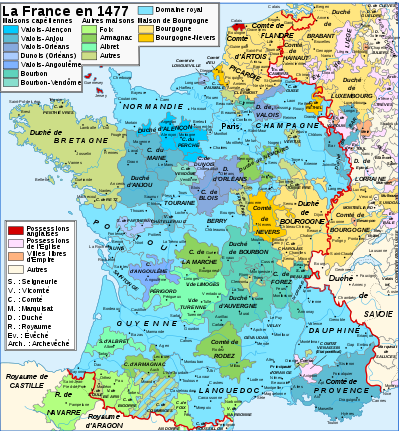
It should not be assumed that the crown pursued a consistent determination to lay hands on all these territories and rule them directly. There was usually a more or less lengthy period of adjustment to a new status. Some apanages and territories taken over by Louis XI were absorbed into the general administration of the rest of the kingdom. This was clearly the case with Burgundy and Picardy-Artois in 1477, both of them in the area under the jurisdiction of the Parlement of Paris. Yet even here, Louis XI had to tread warily in winning over the support of the regional nobility and discontent was apt to break out until the end of the fifteenth century. On Louis's death, for instance, a rising occurred in Picardy at Bertrancourt near Doullens, with cries of 'there is no longer a king in France, long live Burgundy!' The absorption of Artois proved to be an impossible undertaking and had to be renounced in 1493.
Elsewhere, absorption of apanages that were distant from the centre of royal power left affairs locally much as they had been before. The little Pyreneen county of Comminges was governed much as it had been under its counts, with privileges confirmed by Charles VIII in 1496. Only with the work of royal commissioners in the tax-assessing process in the 1540s, the first time an outside power had actively intervened in the affairs of the local nobility, did this begin to change. Auvergne, an apanage raised to a duchy in 1360, was confirmed to the Bourbons in 1425 on condition that their whole domain became an apanage. The duchy was confiscated from the Constable in 1523 but transferred by the king to his mother in 1527 and only absorbed into the royal domain in 1531. Even after that, it formed the dower of Charles IX's queen and then part of the apanage of François d'Anjou, his brother. In the contiguous county of Forez, also confiscated in 1523, little local opposition emerged to the change of regime; although the local chambre des comptes was shortly suppressed, most local judicial officials, along with the entire administrative structure, were retained. Except for a few partisans of the Constable, it seems that there was no great upheaval. Louise de Bourbon, the Constable's sister and princess of La Roche-sur-Yon, demanded a share of the inheritance - Forez, Beaujolais and Dombes. Beaujolais and the principality of Dombes eventually went to Louise's son, Montpensier.
The county of Auvergne, enclaved in the duchy, was held by the duke of Albany in his wife's name, and was then inherited from the last of the La Tour d'Auvergne family by Catherine de Medici. Catherine brought it to the crown by her marriage with Henri II in 1533 but she continued to administer it as her own property. She left it to Charles IX's bastard, Charles de Valois, but her daughter Marguerite made good her claim to it in 1606 and it only entered the royal domain definitively when she willed it to Louis XIII.
After her marriage to Charles VIII in 1491, Brittany was administered as her own property by queen Anne, technically still duchess but in reality sharply circumscribed in her power, until her husband's death restored some of her freedom of action in 1498. Having already established friendly relations with Louis XII when he was still duke of Orleans, she was prepared to accept his offer of marriage after the annulment of his marriage to Louis Xl's daughter, Jeanne, had been agreed. The contract which accompanied the marriage in January 1499 tied the duchy to the crown provisionally on condition that it always passed to the second son of the marriage, while in the absence of issue the duchy was to revert to Anne's heirs on her own side. Anne was able to act rather more independently during her marriage to Louis XII though the conditions of the contract were not observed. On her death Brittany was inherited by her elder daughter Claude, wife of Francis I, who transmitted her rights to her son the dauphin. The queen had, however, transferred the government of the duchy to her husband in 1515 and he continued to rule it in the name of his son François on Claude's death, entitling acts as 'legitime administrateur et usufructuaire' of his son's property. When the dauphin's majority in 1532 brought the question of the imminent personal union of the duchy to the kingdom to the foreground, it was arranged for the Breton estates to 'request' full union with France but on terms which guaranteed Breton privileges and maintained the principle that the dauphin would be duke of Brittany. Only in 1536, on the death of the dauphin, was the union with the kingdom complete and no more dukes were crowned at Rennes. What had been done was the annulment of the Breton succession law, which included females, in favour of the French royal succession law. Late in 1539, it was decided that the new dauphin Henri would have the government of Brittany 'to govern as he pleases', though the documents were delayed by the king's illness. A 'Declaration' transferring Brittany to Henri was drawn up in 1540. In practice, the government of the duchy seems not to have been much changed.
The lands of the house of France-Anjou posed a complex problem. René of Anjou, titular king of Jerusalem, Sicily, Aragon and Naples, was count of Provence in his own right, of Maine and Anjou as apanagiste and Guise by succession. As early as 1478, Louis was scheming to ensure that king René, who had no surviving son, did not leave his territories of Anjou, Provence and Bar to his grandson, René II of Lorraine, warning the general of Languedoc that his region would be 'destroyed' if Provence fell into other hands. On the 'good' king's death in 1480, most of his domains passed to his cousin Charles IV d'Anjou, count of Maine, who died childless in 1481, when Maine and Anjou reverted to the crown, thereafter to be granted out to members of the royal family such as Louise of Savoy. At the same time Provence was acquired by Louis XI by Charles IV's will and the county of Guise was disputed between the houses of Armagnac-Nemours, Lorraine (heirs of René I of Anjou and successors as titular kings of Jerusalem and Sicily) and Pierre de Rohan, marshal de Gié. From 1481, however, the king ruled in Provence as 'count of Provence and Forcalquier'. The lord of Soliès, Palamède de Forbin, who had persuaded Charles d'Anjou to leave the county to the king, was rewarded with the post of governor. The major change came in 1535 with the edicts of Joinville and Is-sur-Tille on the government of Provence, limiting the scope of the old institutions of the Estates and the Sénéchal and increasing that of the Parlement of Aix in justice and of the royal governor in administration. Curiously, Francis I was reported as having said that he felt an obligation to 'ceux de Guise', the house of Lorraine in France, since Louis XI had despoiled them of their inheritance of Provence and Anjou.
The major surviving complex of apanage lands by the middle of the sixteenth century was that held by Antoine de Bourbon, now first prince of the blood and next in line to the throne after the immediate royal family, and his wife Jeanne d'Albret. These involved a group of territories held by different tenures. The Albret inheritance brought the titular kingship of Navarre with a small fragment of the ancient kingdom of Navarre north of the Pyrénées that was held in sovereignty. In the counties of Foix, Albret and Béarn, the family held effective sway under only the most distant royal sovereignty, though Louis XI saw fit to pose as the protector of the young François-Phébus in 1472. In 1476, he sought to revise local tariffs against Albret interests and in 1480 attempts to levy a taille for the gendarmerie there stirred up a rebellion. In western France, the duchy of Vendôme, erected as late as 1515 to detach it from dependence on the duchy of Anjou, was held as an apanage under rather closer royal supervision. In the north, the complex of lands administered from La Fère-sur-Oise and centring the county of Marle was held directly of the king or of the Habsburg ruler of the Netherlands, rendering the family, to some, unreliable. Practical power stemmed from the holding of the governorships of Picardy and of Guyenne by the Bourbons and Henri d'Albret.
Other independent territories persisted, such as the vicomté of Turenne, where the vicomte (of the La Tour d'Auvergne family) ruled with regalian rights until the eighteenth century, could raise taxes, coin money, make war and render justice as a limited monarch in conjunction with very active local estates.
David Potter - A History of France, 1460-1560- The Emergence of a Nation State
#xv#xvi#david potter#a history of france 1460 1560: the emergence of a nation state#louis xi#louis xii#charles iii de bourbon#mathieu de foix#jean v d'armagnac#françois i#charles iv d'alençon#marguerite d'angoulême#rené d'anjou#charles viii#charles ix#élisabeth d'autriche#louise de bourbon#gilbert de montpensier#catherine de medici#house of la tour d'auvergne#charles de valois#louis xiii#anne de bretagne#jeanne de france#claude de france#charles iv d'anjou#louise de savoie#house of guise#capetian house of bourbon#antoine de bourbon
4 notes
·
View notes
Text


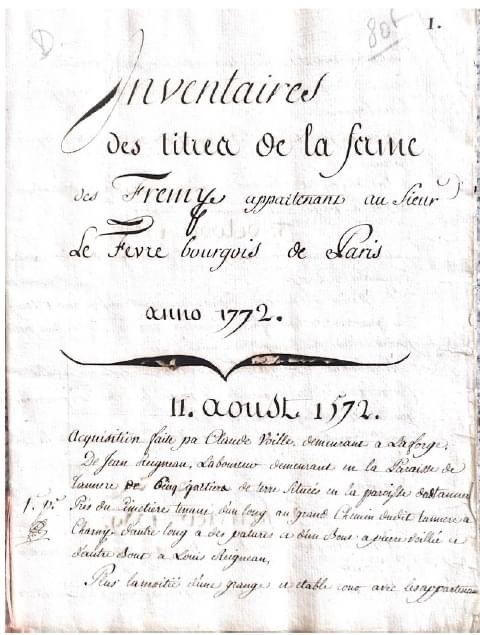
450 ans et pas une ride !!!
©️isabelle buffet
4 notes
·
View notes
Text

Catherine de Medici and Charles IX in an interior
Artist: Paul Hippolyte Delaroche (French 1797-1856)
Date: 19th century
Medium: Oil on canvas
Collection: Private collection
Catherine de' Medici
Catherine de' Medici (Italian: Caterina de' Medici, 13 April 1519 – 5 January 1589) was an Italiana noblewoman born into the Medici family. She was Queen of France from 1547 to 1559 by marriage to King Henry II and the mother of French kings Francis II, Charles IX, and Henry III. The years during which her sons reigned have been called "the age of Catherine de' Medici" since she had extensive, albeit at times varying, influence on the political life of France.
Charles IX of France
Charles IX (Charles Maximilien; 27 June 1550 – 30 May 1574) was King of France from 1560 until his death in 1574. He ascended the French throne upon the death of his brother Francis II in 1560, and as such was the penultimate monarch of the House of Valois.
#painting#interior#oil on canvas#genre art#catherine de medici#house of medici#charles ix of france#sitting#standing#french history#costume#table#chair#letter#window#paul delaroche#french painter#french art#french culture#oil painting#fine art#european art#19th century painting#artwork
26 notes
·
View notes
Text
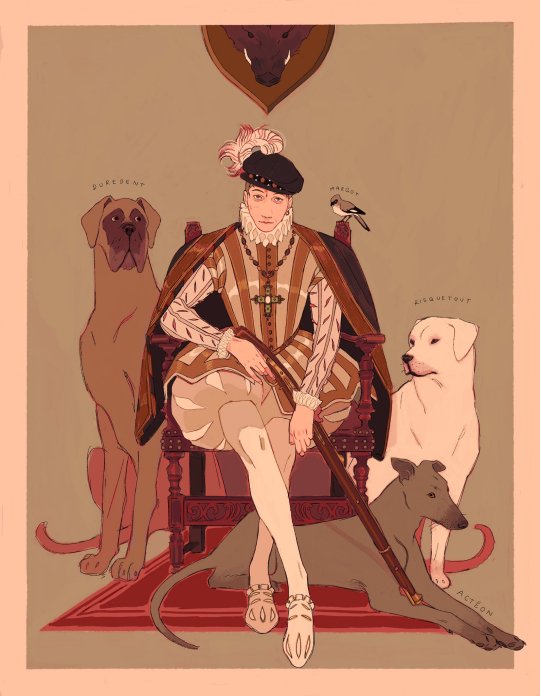
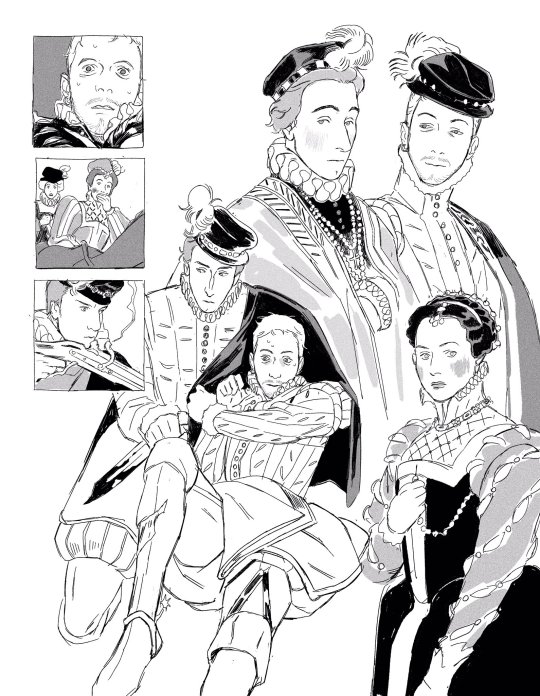
La Reine Margot - Charles IX, Henri de Navarre, and Marguerite de Valois
I.III - Un roi poète
I.XXXI - La Chasse à Courre
II.IV - La Nuit des Rois
#La Reine Margot#Alexandre Dumas#Charles IX#Henri de Navarre#Henri IV#Marguerite de Navarre#new obsession just dropped welcome to the era#Charles is callous and sickly and pathetic so naturally he's a blorbo#he can excuse religious war crimes but he draws the line at his sexy cool protestant brother in law ♥️#i havent even designed the main gays of this book...it has so much to offer#16th century#my art
4K notes
·
View notes
Text









"..- though their reality was far more interesting than any idealized version could possibly be -.."
𝐓𝐡𝐞 𝐒𝐞𝐜𝐫𝐞𝐭 𝐇𝐢𝐬𝐭𝐨𝐫𝐲, 𝐃𝐨𝐧𝐧𝐚 𝐓𝐚𝐫𝐭𝐭
#dark academia#chaotic academia#autumn#fall#books#black cat#library#chess#woods#fog#cards#candles#leaves#tea#coffee#the secret history#donna tartt#richard papen#henry winter#francis abernathy#camilla macaulay#charles macaulay#bunny corcoran#IX ♠️
43 notes
·
View notes
Text


By Courtney Mares
9 November 2024
For the first time in over a century, the historic Chair of St. Peter, a wooden throne symbolizing the pope’s magisterial authority, has been removed from its gilded bronze reliquary in St. Peter’s Basilica to be displayed for public veneration.
Pilgrims and visitors can now behold this storied relic directly in front of the basilica’s main altar, just above the tomb of St. Peter, where it will remain on display until December 8, the Solemnity of the Immaculate Conception.
According to Pietro Zander, Head of the Necropolis and Artistic Heritage Section of the Vatican:
"The last major public viewing of the chair occurred in 1867, when Pope Pius IX exposed the Chair of Peter for the veneration of the faithful for 12 days on the 1,800th anniversary of the martyrdoms of St. Peter and St. Paul."
It was the first time that the centuries-old wooden throne had been exhibited to the public since 1666 when it was first encased within Gian Lorenzo Bernini’s monumental bronze sculpture under the stained-glass Dove of the Holy Spirit window at the basilica’s apse.
Formally known as the Cathedra Sancti Petri Apostoli, or more simply as Cathedra Petri, the chair has held a revered place in Catholic tradition over the centuries, representing papal authority from St. Peter to the present.

“The chair is meant to be understood as the teacher’s ‘cathedra,’” art historian Elizabeth Lev told CNA.
“It symbolizes the pope’s duty to hand down the teaching of Christ from generation to generation.”
She explained:
“It’s antiquity [ninth century] speaks to a papacy that has endured through the ages — from St. Peter who governed a church on the run trying to evangelize with the might of the Roman Empire trying to shut him down, to the establishment of the Catholic Church and its setting down of roots in the Eternal City, to our 266th successor of St. Peter, Pope Francis.”
A Storied History

The wooden chair itself is steeped in history.
According to the Vatican, the wooden seat was likely given by the Holy Roman Emperor Charles the Bald to Pope John VIII in A.D. 875 for the emperor’s Christmas coronation in the old St. Peter’s Basilica.
A depiction of the emperor appears on the crossbeam of the chair, and its ivory panels illustrate the labors of Hercules along with other scenes from Greek mythology.
The informational sign near the chair in St. Peter’s Basilica informs visitors that “shortly after the year 1000, the Cathedra Petri began to be venerated as a relic of the seat used by the apostle Peter when he preached the Gospel first in Antioch and then in Rome.”
The Fabric of St. Peter, the organization responsible for the basilica’s upkeep, maintains:
“It cannot be ruled out that this ninth-century imperial seat may have later incorporated the panel depicting the labors of Hercules, which perhaps originally belonged to an earlier and more ancient papal seat.”
Before returning the chair to its place within Bernini’s monumental reliquary, Vatican experts will conduct a series of diagnostic tests with the Vatican Museums’ Cabinet of Scientific Research.
The ancient seat was last removed and studied from 1969 to 1974 under Pope Paul VI but was not shown to the public.
The recent restoration of Bernini’s works in the basilica, funded by the Knights of Columbus in preparation for the Catholic Church’s 2025 Jubilee Year, made it possible for the chair to be moved from the bronze sculpture in August.
Pope Francis got a sneak peak of the relic in early October and a photo of the moment — showing him sitting in a wheelchair before the Chair of St. Peter — quickly went viral.
Afterward, the pope requested that the relic be displayed for public veneration.

Francis ultimately decided that the Chair of St. Peter — a symbol of the Church’s unity under the instruction of Christ — would be unveiled for the public at the closing Mass for the Synod on Synodality.
“Pope Francis has been exceptionally generous to the faithful about displaying relics,” Lev said.
“He brought out the bones of St. Peter shortly after his election, he had the Shroud of Turin on view in 2015, and now he has taken the Chair of Peter out for veneration in the basilica.”
“In our virtual age, where much confusion reigns between what is real and what is not, Pope Francis has encouraged us to come face to face with these ancient witnesses of our faith and our traditions.”
Feast of the Chair of St. Peter

The Feast of the Chair of St. Peter, celebrated each year on February 22, dates back to the fourth century.
St. Jerome (A.D. 347–420) spoke of his respect for the “Chair of Peter,” writing in a letter:
“I follow no leader save Christ, so I enter into communion with … the Chair of Peter, for this I know is the rock upon which the Church is built.”
As Pope Benedict XVI explained in a 2006 catechesis:
“‘Cathedra’ literally means the established seat of the bishop, placed in the mother church of a diocese, which for this reason is known as a ‘cathedral.”
“It is the symbol of the bishop’s authority and in particular, of his ‘magisterium,’ that is, the evangelical teaching which, as a successor of the apostles, he is called to safeguard and to transmit to the Christian community,” he said.
When a bishop takes possession of the particular Church that has been entrusted to him, he sits on the cathedra, Benedict explained:
“From this seat, as teacher and pastor, he will guide the journey of the faithful in faith, hope, and charity.”
“The Church’s first ‘seat’ was the upper room, and it is likely that a special place was reserved for Simon Peter in that room where Mary, mother of Jesus, also prayed with the disciples,” he added.
Benedict XVI described Peter’s ministry as a journey from Jerusalem to Antioch, where he served as bishop, and ultimately to Rome.
He noted that the See of Rome, where Peter ultimately “ended his race at the service of the Gospel with martyrdom,” became recognized as the seat of his successors, with the cathedra representing the mission entrusted to Peter by Christ.
“So it is that the See of Rome, which had received the greatest of honors, also has the honor that Christ entrusted to Peter of being at the service of all the particular Churches for the edification and unity of the entire people of God,” he said.
Bernini’s Baroque Masterpiece

Bernini’s monumental reliquary for the chair, commissioned by Pope Alexander VII and completed in 1666, is one of the most iconic artworks in St. Peter’s Basilica.
Bernini encased the wooden relic within a bronze-gilded throne, dramatically raised and crowned by a stained-glass depiction of the Holy Spirit, symbolized as a dove, surrounded by sculpted angels.
The bronze throne is supported by massive statues of four doctors of the Church — two from the West, St. Augustine and St. Ambrose, and two from the East, St. John Chrysostom and St. Athanasius.
It is symbolizing the unity of the Church through the ages, bringing together the teachings of both the Latin and Greek Church Fathers.
And at the top of the throne, cherubs hold up a papal tiara and keys symbolizing papal authority.
On the chair itself, there are three gold bas-reliefs representing the Gospel episodes: "consignment of the keys" (Matthew 16:19), “feed my sheep” (John 21:17), and the "washing of the feet" (John 13:1-17).
The ongoing restoration of Bernini’s monument at the Altar of the Chair, along with the recently finished restoration of the baldacchino, is significant not only in light of the 2025 Jubilee Year but also the upcoming 400th anniversary of the Consecration of the Current St. Peter’s Basilica in 2026.
Benedict XVI said:
“Celebrating the ‘Chair’ of Peter means attributing a strong spiritual significance to it and recognizing it as a privileged sign of the love of God, the eternal Good Shepherd, who wanted to gather his whole Church and lead her on the path of salvation.”

#Chair of St. Peter#St. Peter’s Basilica#Vatican#gilded bronze reliquary#St. Peter#Solemnity of the Immaculate Conception#Pope Pius IX#Necropolis and Artistic Heritage Section#Gian Lorenzo Bernini#Dove of the Holy Spirit#Cathedra Sancti Petri Apostoli#Cathedra Petri#wooden chair#Holy Roman Emperor Charles the Bald#Pope John VIII#Fabric of St. Peter#Vatican Museum#Cabinet of Scientific Research#Pope Paul VI#Knights of Columbus#2025 Jubilee Year#Synod on Synodality#Feast of the Chair of St. Peter#St. Jerome#See of Rome#Pope Alexander VII#iconic artworks#Altar of the Chair#baldacchino
8 notes
·
View notes
Text

The Hunter becomes the Hunted (but with a typo)
#sigh#la reine margot#i made a coloured version too but i dont like it#anyways.#🧩#charles ix#alexandre dumas
31 notes
·
View notes
Text
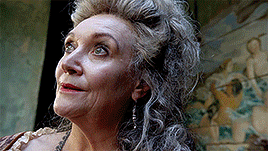





A Big Undertaking Black Sails Musical Parallels | V. VIII. IX.
I spent a year rewatching Black Sails and tracking all the bits of music that repeated at any point during the show, and my findings are reinforcing that Bear McCreary is a genius and this show should have been called 'parallels that will kill you over and over again'* (tag | chronological)
#black sails musical parallels#V. a#black sails#sabsmade#V#VIII#IX#jack rackham#mrs mapleton#charles vane#anne bonny#john silver#james flint#captain flint#listen fuck dufresne flint will never not be captain#1.5#1.8#2.1#mine#bear mccreary#blacksailsedit
91 notes
·
View notes
Text
The Consequences of the Massacre of Wassy
Commerative plaque to the Massacre at Wassy (Photo credit: Ji-Elle from Wikimedia Commons) French history has been a favorite of mine since college days when the designated professor was eccentric and gave fascinating lectures. Those are fond memories. Recently, my reading list has included lots of French history, especially the sixteenth century and the Renaissance era. A certain incident in…

View On WordPress
#Antoinette de Bourbon#Catherine de’Medici#Charles IX#Duke of Guise#Elizabeth I#Francis II#French Catholics#French history#French Reformation#French Wars of Religion#King of France#Mary Queen of Scots#Mary Stuart#Massacre of Wassy#Protestants#Queen of England#Queen of France#Queen of Scotland#Renaissance#Stuart history#Tudor history#Wassy
2 notes
·
View notes